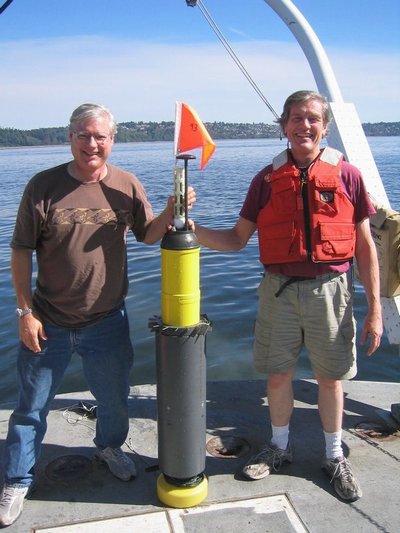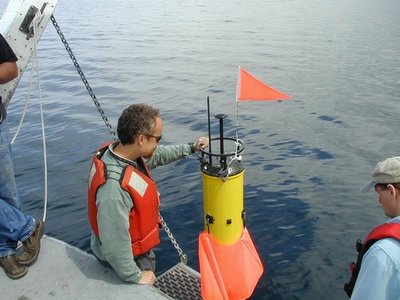September 15, 2004
Oceanographers seek to better understand ferocity of hurricanes like Frances
Five floats loaded with instruments and deployed in the path of the eye of hurricane Frances have transmitted data that may help scientists better understand ocean conditions that put a damper on tropical storms and those that pour on the gas.
University of Washington scientists and engineers designed and built the floats, the most specialized oceanographic instruments ever deployed in the path of a hurricane, and arranged to have them dropped by aircraft into the ocean a day before the storm was to arrive. They were among numerous devices and aircraft monitoring conditions during Hurricane Frances.
The floats were programmed to travel up and down in the ocean recording initial ocean conditions and then, as the hurricane passed by, measure changes in water temperature, salinity and velocity and the amounts of heat and gas given off. The floats surfaced in order to transmit data via the Iridium cell phone system after the storm passed.
While forecasting hurricane tracks has become better and better, our ability to determine the potential ferocity of such storms has not advanced nearly as far. Studying the interplay between the ocean and atmosphere in the face of hurricane-force winds is one step in improving the models used to predict the strength of tropical storms.
Scientists know, for instance, that hurricanes draw their energy from warm ocean waters, but the resulting intensification depends on such things as how thick the layer of warm water is initially, how much the growing storm winds cause the ocean surface to cool and how much cold water from below gets mixed into the warmer upper layer because of the turbulence produced by the winds.
“We need to know how much heat is transferred from the water to the air in order to know how strong a hurricane will be. Current models of this are just guesses,” says Eric D’Asaro, a principal oceanographer with the University of Washington’s Applied Physics Laboratory.
The give and take of momentum between ocean water and the atmosphere is also important.
“Water can give energy to a hurricane if it is warm, but water can also absorb lots of energy from wind sheer, something we have yet to be able to understand,” says Tom Sanford, a principal oceanographer with the UW’s Applied Physics Laboratory.
The work is funded by the Office of Naval Research and National Science Foundation.
Probes, such as temperature probes, have been dropped for years in the paths of hurricanes, but most are on a one-way journey from the surface to the seafloor. Three of the floats deployed in front of Frances, on the other hand, made more than 100 trips up and down from just below the surface to depths of 650 feet and occasionally as deep as 1,625 feet.
And the floats didn’t just record temperature. For example, three were outfitted with a combination of instruments to measure temperature, salinity and velocity that is unique for autonomously profiling floats, Sanford says. The other two floats measured the flux of heat and gas from the ocean to the atmosphere, another first for these types of floats.
###
The floats
Two mixed layer floats (MLF2s):
- Developed and built at the UW’s Applied Physics Laboratory.
- Descended to profile the ocean ahead of Frances, then ascended to near the surface to monitor heat and gas exchange as the storm passed over, and finally descended again to profile the ocean after the storm passed. The floats had to be delicately balanced to perform properly. “Each float weighs as much as a small person and we had to adjust its weight to better than the weight of a quarter,” D’Asaro says.
- Measure heat flux, important because hurricanes are fueled by warm ocean water underneath them.
- Measure gas flux because, aside from hurricanes, modelers concerned with how much carbon dioxide is absorbed by the world’s oceans would like to know how much carbon dioxide oceans take from the atmosphere and thus help control possible global warming effects.
- Funding for hurricane portion of work from Office of Naval Research through its Coupled Boundary Layers and Air-Sea Transfer program (see http://www.whoi.edu/science/AOPE/dept/CBLAST/hurricane.html) that involves a dozen other institutions; funding for gas flux work is from the National Science Foundation.
- See “MLF2” section of http://opd.apl.washington.edu/~dasaro/FLOATTECH/floats.html for more information. (Also MLFs deployed in front of Hurricane Dennis, 1999, with published results, are described at http://opd.apl.washington.edu/~dasaro/DENNIS/Text.html).
For more information about the MLF2s, contact Eric D’Asaro, 206-524-5267 (home), dasaro@apl.washington.edu, dasaro@u.washington.edu
Three Electromagnetic-Autonomous Profiling Explorers (EM-APEXs):
• Autonomous Profiling Explorer developed by Webb Research Corp., Falmouth, Mass. (http://www.webbresearch.com/), with software and circuit modifications by engineers with the UW’s Applied Physics Laboratory so the floats measure the ocean’s velocity electromagnetically.
• Monitored water temperature, salinity and velocity while continuously profiling from the surface to 200 meters deep, with excursions to 500 meters deep every 16 hours. Each made more than 100 up-and-down profiles, mostly while underwater. On the surface after five days with their heads “down” so their antenna avoided the chaotic surface, they called in the profile date over the Iridium satellite cell phone system.
• Measure how ocean momentum responds to hurricane winds and rain.
• Funding for float adaptation through Office of Naval Research Small Business Innovation Research program (see: http://www.navysbir.com/) that works with private firms such as Webb Research Corp. Webb Research will make the new floats available commercially to researchers and companies needing to monitor deep ocean conditions. The new floats might, for example, be used by oil firms deciding where to site new drilling platforms or by researchers studying other hurricanes or global ocean climate changes.
For more information about the EM-APEXs contact: Thomas Sanford, 206-543-1365, sanford@apl.washington.edu




